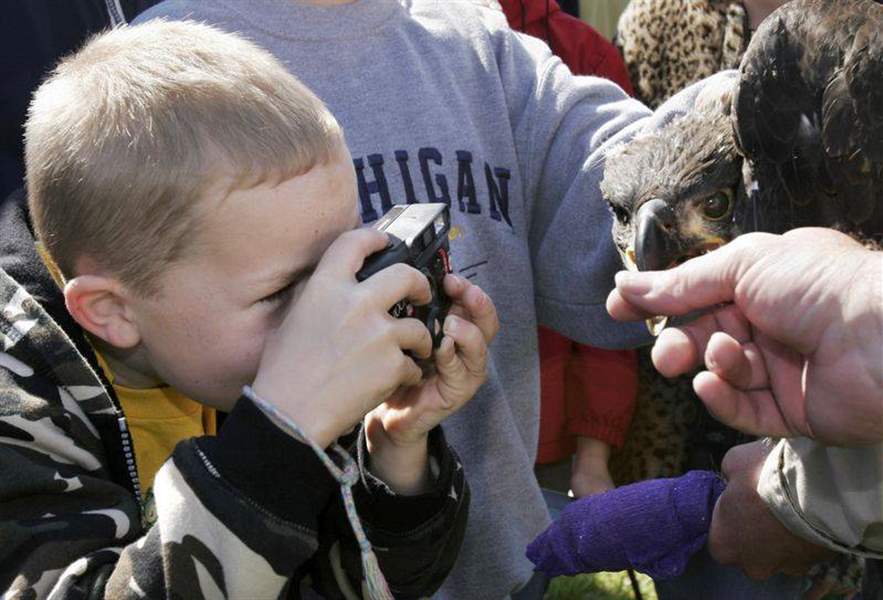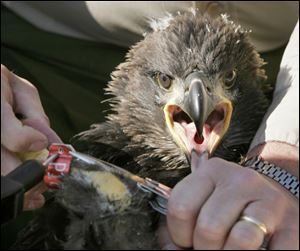
Baby eagle wows public
5/21/2005
Gabe Burton, 8, takes a close-up of the eaglet.

Mark Shieldcastle, a state biologist, puts an identification band on an eaglet whose nest is at Camp Perry.
PORT CLINTON Sherri Bacak couldn t help feeling a bit maternal as a group of schoolchildren crowded around the newborn, rubbing his head and leaning forward to talk to him.
The Port Clinton woman, a volunteer for the Ohio Department of Natural Resources, spent hours this spring watching a nest in a cottonwood tree while a bald eagle pair hatched, warmed, and fed the young bird.
Yesterday, staff members with the Ohio Division of Wildlife fetched the eaglet from his home 70 feet above Camp Perry, measured and banded him, and showed him off to more than 100 visitors.
It s my baby, Ms. Bacak said, watching the onlookers stroke the 7 -week-old bird, held by two Division of Wildlife employees. I always tell people this is my nest. It s like having my own child. I m so proud.

Gabe Burton, 8, takes a close-up of the eaglet.
The banding, open to the public, was a rare chance for wildlife enthusiasts to see the national bird up close.
That s cool! exclaimed Andy Dix, 8, a second-grade student at Woodmore Elementary School as he caressed the eaglet s dark brown feathers behind his head. It feels smooth and stuff.
Afterward, the boy snapped some photos of the bird with a disposable camera.
Sarah Blusey, 7, a first-grader at the Woodville school, expressed surprise after touching the eaglet: It s soft, she said, smiling shyly.
Mark Shieldcastle, project manager for the Division of Wildlife, said two climbing crews have been bringing young eagles down from selected nests to check on their health and band them for fu-
ture reference.
The eaglet s relatively small size indicated to Mr. Shieldcastle and Andrea Tibbels, a wildlife research technician, that the bird was a male. Among eagles and other raptors, females are larger than males, Mr. Shieldcastle explained.
To retrieve the bird, Division of Wildlife biologist Mark Witt scaled the tree and positioned himself next to the giant nest of sticks and mud.
The eaglet, which won t be able to fly for another three weeks, flapped its wings in protest but couldn t stop Mr. Witt from hooking one of its legs with a piece of chicken wire.
The biologist carefully pulled the bird toward him, then placed him in a nylon bag and attached it to a pulley system that lowered the eaglet to the ground.
It was a pretty feisty character, Mr. Witt said afterward. I had to put on my gloves because he was biting me.
Ms. Bacak had reported seeing two young birds in the nest shortly after the eagle pair hatched early this spring, but Mr. Witt said he found no signs of a second eaglet in the nest. He did, however, see evidence that the surviving eaglet was being well fed, including remains from largemouth bass, bowfin, fox squirrel, raccoon, rabbit, and muskrat.
That bird was in good shape, Mr. Shieldcastle said. He wasn t stressed at all.
So far this spring, the Division of Wildlife has confirmed the presence of at least 123 eaglets in 125 nests around the state. A late-April snowstorm killed at least 11 young, but Mr. Shieldcastle said biologists still hope to surpass last year s total of 127.
The number of young born this spring continues a remarkable comeback for the bald eagle over the past quarter-century. In 1979, when the Division of Wildlife started a statewide restoration program, just four bald eagle pairs were found nesting in Ohio.
Dave Graham, assistant chief of the Division of Wildlife, credited volunteer nest watchers like Ms. Bacak for helping the recovery effort.
Without them, the division wouldn t be able to monitor all of the state s nests.
We wouldn t have the number of birds we have in the state of Ohio without them, he said. When I started my career 30 years ago, I actually thought we were going to lose eagles in Ohio.
Contact Steve Murphy at:smurphy@theblade.comor 419-724-6078.